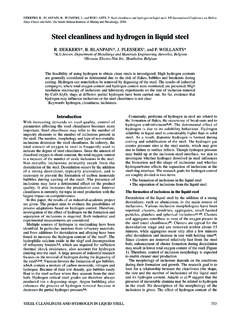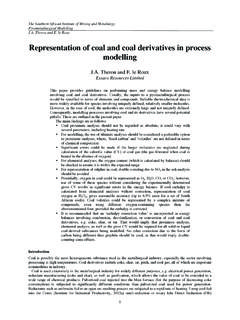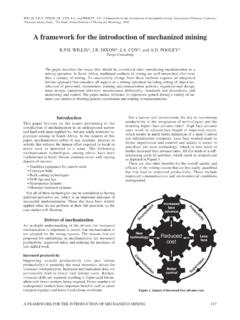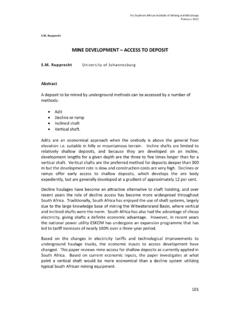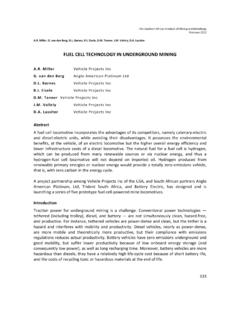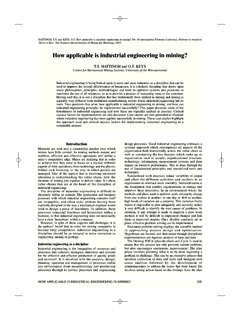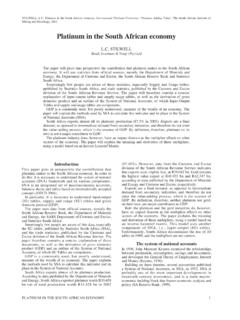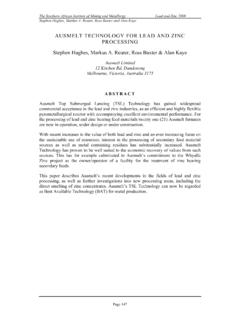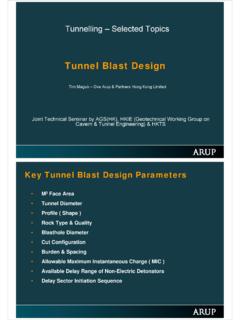Transcription of A REVIEW OF THE DESIGN CRITERIA AND …
1 The South African Institute of Mining and Metallurgy International Symposium on Stability of Rock Slopes in Open Pit Mining and Civil Engineering Simon St J Tose _____ Page 525 A REVIEW OF THE DESIGN CRITERIA AND PRACTICAL ASPECTS OF DEVELOPING A SUCCESSFUL PRE-SPLIT. Simon St J Tose African Explosives Limited ABSTRACT The objective of this paper and presentation is to REVIEW the different CRITERIA and methodology used by AEL and other organisations to create a pre-split DESIGN which delivers a stable highwall for the life of that part of the mining operation. It will look at the need to adapt and change the way, size and direction of the production blasts as the mining phase approaches the highwall position for which a pre-split has been created.
2 Key Words: Pre-split: DESIGN ; Highwall; Perimeter 1. Introduction In both surface and underground mining operations there is a need for the use of special blasting techniques to improve highwall stability and reduce overbreak. The names given to these techniques vary, but here the term "Perimeter Blasting" refers to all methods which have the aim of minimizing blast damage to the excavation perimeter by preventing the force of a blast from continuing into the highwall. Much of the following discussion on controlled blasting techniques has been determined through years of on-the-job testing and evaluation. The results of controlled blasting are primarily a function of the geology, especially the number and orientation of joint and fracture planes and the quality of the final rock surface that is required.
3 In many circumstances the confined gas energy from explosives can significantly reduce the structural strength of the rock behind and to the sides of the blasted volume. This will also be caused by blasts that have high charge masses per delay. New fractures and planes of weakness are created and joints and bedding planes that may have been stable before the blast but can be opened up. As a result the rock mass stability can be reduced. This can be seen as overbreak and the fractured face is left with a higher likelihood of rock falls, figure 1. The South African Institute of Mining and Metallurgy International Symposium on Stability of Rock Slopes in Open Pit Mining and Civil Engineering Simon St J Tose _____ Page 526 When modified production blasts cause too much damage on final walls, perimeter blasting methods need to be used.
4 The best perimeter blasting results can be achieved in tough massive rocks. In unconsolidated, weathered or highly fissured rocks, problems in obtaining a consistently smooth wall are usually encountered, but the overall result is always much better than the result from production blasts alone. The perimeter blasting technique used depends on the rock type. Blasting of weak, highly fissured ground requires a more conservative DESIGN than blasting in tough massive rock. Blasthole patterns and charge loads will therefore change appreciably with the rock properties encountered. Perimeter blasting techniques are therefore more costly than re-designed production blasting because of the greater amount of drilling required.
5 It is essential that drilling and charging be carefully supervised because the final result depends heavily on the time spent and accuracy of drilling. The general approach in Perimeter Blasting is to: Reduce backbreak from production blasting Reduce charge masses in the perimeter holes and often in the last production or perimeter easer holes as well, Drill extra holes in order to compensate for the reduced charge mass per hole and to provide a preferential plane of weakness delineating the final excavation perimeter, and Arrange the initiation of the perimeter holes so as to obtain maximum relief of burden and mobilize preferential splitting mechanisms.
6 2. Reducing backbreak from production blasting Because perimeter blasting is more expensive than normal blasting, attempts should first be made to reduce backbreak by modifying the standard drilling and charging methods. The following aspects of blast DESIGN should be considered when designing blasts to limit overbreak: The South African Institute of Mining and Metallurgy International Symposium on Stability of Rock Slopes in Open Pit Mining and Civil Engineering Simon St J Tose _____ Page 527 If a continuous column of explosive is too powerful for back-row blastholes, use an air deck to reduce blasthole pressure In water-filled blastholes, semi-rigid explosives cartridges should be used in perimeter holes to give charges which build up a continuous column but which are also a loose fit in the blasthole.
7 Using 45 mm diameter cartridges in 89 mm blastholes would be a suitably de-coupled charge (A coupling ratio of about 25% or less should be aimed for) The effective burden on perimeter holes should not be greater than about 25 times the blasthole diameter, preferably about 20 times. The best spacing between back-row blastholes is the largest spacing that gives a straight face. The spacing needs to be determined by trials; however it usually lies between 25 and 40 times the blasthole diameter. In multi-row shots, blastholes should be staggered. If possible drill angled rather than vertical blastholes at least for the last 3 to 4 rows in front of the final wall.
8 Angled blastholes tend to cause less damage to the crest behind the back row. Angles of 20o - 30o to the vertical are recommended. Be warned however that angled blastholes tend to produce more flyrock. For all blastholes except those in the back row, the length of the stemming column is commonly about 25 blasthole diameters. Because of the need to prevent surface overbreak, it is necessary to increase the stemming length in the back row (Figure 2). Sub-drilling into the final crest or berm should be minimised because cracks generated by explosion gases will allow water into the berm, therefore increasing the rate of breakdown due to weathering.
9 The initiation sequence should be selected so that there are minimum numbers of blastholes firing on the same delay and preferably firing takes place hole by hole. The South African Institute of Mining and Metallurgy International Symposium on Stability of Rock Slopes in Open Pit Mining and Civil Engineering Simon St J Tose _____ Page 528 The blast in figure 2 shows a combination of features, which give reduced overbreak. This DESIGN also gives good fragmentation, displacement and looseness of the muckpile. The limited amount of overbreak results from: Blastholes firing on individual delays, particularly those in the back row.
10 Hole-by-hole Relatively long delays between rows Favourable relief for blastholes resulting from development of a wide V Angle of blastholes Longer stemming columns in back-row blastholes A good guide as to whether a modified production blast will give a satisfactory final wall is the state of the back wall from current production blasting. If blasthole traces can be seen on the back walls of current production blasts, then good final walls should be fairly easy to achieve. Smoothwall blasting techniques ( pre-splitting) are generally required where the rock is weak or densely fissured, or where it is important to maximise the soundness and stability of the rock wall.
